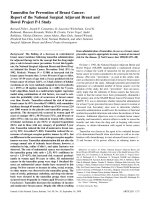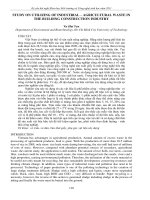CERTIFICATE OF ORIGINALITY OF STUDY PROJECT REPORT
Bạn đang xem bản rút gọn của tài liệu. Xem và tải ngay bản đầy đủ của tài liệu tại đây (603.94 KB, 74 trang )
CERTIFICATE OF ORIGINALITY OF STUDY PROJECT REPORT
I certify my authority of the Study Project Report submitted entitled
A VIETNAMESE - AMERICAN CROSS-CULTURAL STUDY
OF CONVERSATIONAL DISTANCES
In fulfilmentfulfillment of the requirements for the degree Master of Arts
Le Thi Huyen
Acknowledgements
I owe my deepest gratitude to my supervisor, M.A Nguyen Thi Thanh Huong,
without whose valuable comments and guidance, my thesis would not have been
accomplished.
My special thanks go to my colleagues from Haiphong Water Supply Company,
those who helped me fill in my survey questionairequestionnaire and give me
constructive suggestions in completing this thesis.
And I am immensely grateful to my former teacher, Ms. Stacy Thompson, who
is living and working in the United States. She has helped me conduct my
survey in the United States.
I owe my family great attitude for theirMy family: my parents, my brother,
my sister-in-law and my boyfriend have been a constant source of love,
support and encouragement.
Finally, I should acknowledge my indebtedness to all my friends for their
assistance during the process of preparing for this research.
Le Thi Huyen
ABSTRACT
Even the best verbal communication skills are not enough to create and sustain successful
relationships. Good relationships, both at home and at work, require the ability to
communicate with emotional intelligence.
Part of our culture involves an unspoken rule that people should ignore nonverbal elements–
as if the injunction were, "hear what I say, and don't notice the way I say it." These elements
are often ignored in school or overridden by parents, so the task of incorporating conscious
sensitivity to nonverbal communications is made more difficult. Thus, this thesis is an
attempt to provide a cross-cultural comparison of common conversational distances, their
frequency used in American and Vietnamese cultures and factors affecting conversational
distances.
Special emphasis is given to :
- classification and usage of conversational distances as well as and their usage
- factors affecting conversational distances.
The implications are suggested and recommendations provided for avoidance of culture
shock and cross-cultural communication breakdown. For instance, American people tend to
use close phase of intimate distance when showing intimate emotion with mothers more than
Vietnamese. Besides, there is not much difference whether between brothers or sisters in
keeping intimate distance when showing intimate emotion in American, whereas,
Vietnamese people tend to keep closer distance with their sister than brother. It is also
concluded that if two Americans of opposite sex informants are conversing, they find close
phase easier, freer and more conventional , however, it is applied for every case that if the
communicative partners are of the same sex then closer distance is more popular with
Vietnamese informants.
LIST OF TABLES AND FIGURES
Figure 1: Percentage of verbal and nonverbal communication in common use
Diagram 1: Classification of nonverbal communication
Table 1: Further clarification of nonverbal communication
Table 2: Sub-distances of intimate distance and their communicators
Table 3: Sub-distances of personal distance and their communicators
Table 4: Sub-distances of social distance and their communicators
Table 5: Sub-distances of public distance and their communicators
Table 6: Interactions among messages, tones of voice and distances between faces
Table 7: Figures on using conversational distances by informants with their mother
Table 8: Figures on using conversational distances by informants with their father
Table 9: Figures on using conversational distances by informants with their brother
Table 10: Figures on using conversational distances by informants with their sister
Table 11: Figures on using conversational distances by informants with their same-sex close friend
(two male friends)
Table 12: Figures on using conversational distances by informants with their same-sex close friend
(two female friends)
Table 13: Figures on using conversational distances by informants with their opposite-sex close
friend
Table 14: Figures on using conversational distances by informants with their same-sex acquaintance
Table 15: Figures on using conversational distances by informants with their opposite-sex
acquaintance
Table 16: Figures on using conversational distances by informants with their same-sex colleague
Table 17: Figures on using conversational distances by informants with their opposite-sex colleague
Table 18: Figures on using conversational distances by informants with their boss
Table 19: Figures on using conversational distances by informants between 20 and 40 years old
Table 20: Figures on using conversational distances by informants above 40 years old
Table 21: Figures on using conversational distances by male informants
Table 22: Figures on using conversational distances by female informants
Table 23: Figures on using conversational distances by informants living in rural areas
Table 24: Figures on using conversational distances by informants living in urban areas
Table 25: Figures on using conversational distances by informants with teamwork occupation
Table 26: Figures on using conversational distances by informants with independent work
occupation
TABLE OF CONTENTS
PART A: INTRODUCTION.............................................................................1
I. Rationale....................................................................................................1
II. Aims of the study......................................................................................2
III. Scope of the study...................................................................................2
IV. Methodology...........................................................................................3
V. Design of the study...................................................................................3
PART B: DEVELOPMENT.............................................................................4
ChapterHAPTER 1: Literature reviewBACKGROUND CONCEPTS............4
1. What is communication?...........................................................................4
1.1 Definition of communication..............................................................4
1.2 Types of communication.....................................................................6
2. What is nonverbal communication?..........................................................7
2.1 Definition of nonverbal communication.............................................8
2.2 Significance of nonverbal communication........................................10
2.3 Main categories of nonverbal communication..................................11
CHAPTERhapter 2: Conversational distance as nonverbal communication
CONVERSATIONAL DISTANCES AS NONVERBAL
COMMUNICATION......................................................................................16
.....................................................................................................................16
1. Definition of conversational distances....................................................16
2. Classification of conversational distances...............................................18
2.1 Intimate distance ...............................................................................18
2.2 Personal distance...............................................................................21
2.2 Personal distance...............................................................................21
(Photo credits: dantri.com.vn).................................................................22
2.3 Social distance...................................................................................23
2.4 Public distance...................................................................................25
3. Factors effecting conversational distances..............................................26
3.1 High - low contact culture.................................................................26
3.2 Gender...............................................................................................27
3.3 Relationship.......................................................................................27
3.4 Age....................................................................................................28
3.5 Population density.............................................................................29
3.6 Intended message..............................................................................30
ChapterHAPTER 3: Data aAnalysis and dDiscussionATA ANALYSIS AND
DISCUSSION.................................................................................................31
1. Methodology...........................................................................................31
1.1 Participants........................................................................................31
1.2 Instruments........................................................................................31
1.3 Procedures of data collection.............................................................31
2. Data analysis and findings.......................................................................33
23.1 Use of converstionalconversational distance as seen from
communicative partnert’s role relationship.............................................33
3.1.1 Data analysis...................................................................................33
23.2 Use of conversational distance as seen from informants’ parameters
.................................................................................................................42
PART C: CONCLUSION...............................................................................47
I. Summary of main findings:......................................................................47
II. Implications for avoidance of culture shock and cross-cultural
communication breakdown.........................................................................47
III. Suggestion for further study..................................................................50
Appendices
References???
Appendices???
PART A: INTRODUCTION
I. Rationale
Stated briefly, how something is expressed may carry more significance and weight than
what is said, the words themselves. Accompanied by a smile or a frown, said with a loud,
scolding voice or a gentle, easy one, the contents of our communications are framed by our
holistic perceptions of their context. Those sending the messages may learn to understand
themselves better as well as learning to exert some greater consciousness about their manner
of speech. Those receiving the messages may learn to better understand their own intuitive
responses–sometimes in contrast to what it seems "reasonable" to think.
The use of physical space by individuals in their interactions with others can be considered
as one of the most critical signals of nonverbal communication as this use of physical space
seems to be different from culture to culture; thus, ways of interpretation of the same space
message are also various. In the 1950's, American anthropologist Edward T. Hall pioneered
proxemics to describe set measurable distances between people as they interact. Like gravity,
the influence of two bodies on each other is inversely proportional not only to the square of
their distance but possibly even the cube of the distance between them (Hall, 1966).
Hall notes that different cultures maintain different standards of personal space. In Latin
cultures, for instance, those relative distances are smaller, and people tend to be more
comfortable standing close to each other; in Nordic cultures the opposite is true. Realizing
and recognizing these cultural differences improves cross-cultural understanding, and helps
eliminate discomfort people may feel if the interpersonal distance is too large ("stand-
offish") or too small (intrusive). Comfortable personal distances also depend on the culture,
social situation, gender, and individual preference.
In this thesis, we will discuss conversational distances and its effects on human
communication. Additionally, we will compare and contrast the way Vietnamese and
American informants apply conversational distances with certain subjects. It is expected that
the findings will, to a certain extent, raise readers’ awareness of the importance of nonverbal
1
communication and provide useful recommendations to Vietnamese learners of English for
avoidance of culture shock in conversational distances when conducting face-to-face
interactions with their Anglophone partners.
II. Aims of the study
The aims of the study are:
To investigate types of conversational distances in human interactions
To compare and contrast types of conversational distances in human interactions and
the influence of the informants’ parameters on conversational distances in the two
cultures in order to clarify similarities and differences in the way the Vietnamese and
the American apply conversational distances.
To provide recommendations to the Vietnamese learners of English for avoidance of
culture shock in conversational distances.
In order to achieve the aims of the study, the following research questions are to be
addressed:
1. What are the conversational distances of the Vietnamese informants in given
situations?
2. What are the conversational distances of the American informants in given
situations?
3. What are the main similarities and differences in conversational distances between
Vietnamese and American informants?
4. What are the recommendations to the Vietnamese learners of English for avoidance
of culture shock in conversational distances?
III. Scope of the study
The study stresses upon the nonverbal communication. Extralinguistically, the study
especially discusses the conversational distances in the two cultures: Vietnamese and
American.
2
IV. Methodology
As the study dwells largely on the practical aspects of cross-cultural communication, the
main method employed in the study is quantitative with due reference to qualitative method.
Besides, contrastive analysis is also used. Therefore, all considerations, comments and
conclusions in this thesis are largely based on:
Reference to relevant home and foreign publication in both primary and secondary
research;
Survey questionairesquestionnaires;
Statistics, descriptions and analysis of the collected and selected data;
Personal observations and experience;
Consultations with supervisors;
Discussions with Vietnamese and foreign teacherscolleagues
V. Design of the study
The study falls into three main parts:
PART A: INTRODUCTION:
Rationale
Aims of the study
Scope of the study
Methods of the study
Design of the study
PART B: DEVELOPMENT:
Chapter 1: Background concepts
Chapter 2: Conversational distances as nonverbal communication
Chapter 3: Data analysis and discussion
3
PART C: CONCLUSION
PART B: DEVELOPMENT
ChapterHAPTER 1: Literature reviewBACKGROUND
CONCEPTS
In this chapter, definition and types of communication will be presented. Simultaneously,
definition of nonverbal communication will be given out and significance of nonverbal
communication shall also be taken into consideration in order to emphasize its role in
human interactions.
1. What is communication?
1.1 Definition of communication
There have been many definitions of “communication” with various emphasis on different
factors. According to Nguyen Quang (F:27), they can be classified withinto:
Emphasis on the hearer:
According to Ronald B. Alder & George Rodman (1998), “: Ccommunication refers to
the process man being responding to the face-to-face symbolic behaviour of other persons”.
Emphasis on both the speaker and the hearer:
This point of view is shared by Ronald B. Alder & George Rodman (1998) and Levine
and Adelman (1993). If Ronald B. Alder & George Rodman (1998) supposed that “:
Ccommunication refers to the process man being responding to the face-to-face symbolic
behaviour of other persons”, .
Levine and Adelman (1993) described it as: T “the process of sharing meaning through
verbal and nonverbal behaviour”.
Emhasis on the meaning of the intended message:
4
If Zimmerman et al. (1991: 4) mentioned this when illustrating communcation as: T “the
process in which persons assign meanings to events and especially to the behaviour of other
persons”, .
Verderber (1989: 4) had another approach: “Communication may be defined as the
transactional process of creating meaning. A transactional process is one in which those
persons communicating are mutually responsible for what occurs”.
Emphasis on the message conveyed:
Saville-Troike (1986) identified that: C “communication is [...] considered the process of
sharing and exchanging information between people both verbally and nonverbally”.
Emphasis on the information, concept, attitude and emotion of the message
conveyed:
It is clarified in the definition of Hybels, S. and Weaver, R. (1992: 5) that: “c
Communication is any process in which people share information, ideas and feelings that
involve not only the spoken and written words but also body language, personal mannerisms
and style, the surrounding and things that add meaning to a message”.
Among the definitions above-mentioned above, the one proposed by Hybels & Weaver
(1992) is the most sufficient and convincing since they have, according to Nguyen Quang (F:
29),
- pointed out the action, interaction and transaction nature of communication;
- specified the characteristics of communication
,- specified the means to carry out communication and
- specified different levels of communication.
5
1.2 Types of communication
Hybels, S. and Weaver, R II (1992: 14) explain that there are different kinds of
communication, among which the most frequently used ones areoften used kinds are:
intrapersonal, interpersonal, interviews, small group and public communication.
Intrapersonal communication
Intrapersonal communication is communication that occurs within us. It involves thoughts,
feelings and the way we look at ourselves. Because intrapersonal communication is centered
in the self, you are the only sender-receiver. The message is makde up of your thoughts and
feelings. The channel is your brain, which processes what you are thinking and feeling.
There is feedback in the sense that as you talk to yourself, you discard certain ideas and
replace them with others.
Interpersonal communication
Interpersonal communication occurs when we communicate on a one-to-one basis - usually
in an informal, unstructured setting. This kind of communication occurs mostly between two
people, though it may include more than two.
Interpersonal communication uses all the elements of the communication process. In a
conversation between friends, for example, each brings his or her background and
experience to the conversation. During the conversation each functions as sender-receiver.
Their messages consist of both verbal and nonverbal symbols. The channels they use the
most are sight and sound. Because interpersonal communication is between two (or a few)
people, it offers the greatest opportunities for feedback. The persons involved in the
conversation have many chances to check that the message is being perceived correctly.
Interpersonal communication usually takes place in informal and comfortable settings.
Interview
An interview is a series of questions and answers, usually involving two people whose
primary purpose is to obtain information on particular subject. One common type is the job
6
interview, in which the employer asks the job candidate questions to determine whether he or
she is suitable for the job. Another type is an information interview where the interviewer
tries to get information about a particular subject.
In interviewing, the sender-receivers take turns talking - one person asks a question and the
other responds. Both persons, however, are continuously and simultaneously sending
nonverbal messages. Because interviews usually take place face to face, a lot of nonverbal
information is exchanged. Feedback is very high in an interview. Since the interview has a
specific purpose, the communication setting is usually quite formal.
Small group communication
Small group communication occurs when a small number of people meet to solve a problem.
The group must be small enough so that each member in the group has a chance to interact
with all other members.
Because small groups are made up of several sender-receivers, the communication process is
more complicated than in interpersonal communication. With so many more people sending
messages, there are more chances for confusion. Messages are also more structured in small
group because the group is meeting together for a specific purpose. Small groups use the
same channels as interpersonal communication, however, and there is also a good deal of
opportunity for feedback, and the settings are also more formal.
Public communication
In public communication the sender-receiver (speaker) sends a message (the speech) to an
audience. The speaker usually delivers a highly-structured message, using the same channels
as interpersonal communication and small-group communication. In public communication,
however, the channels are more exaggerated than in interpersonal communication. The voice
is louder and the gestures are more expeansive because the audience is bigger. Generally, the
opportunity for verbal feedback in public communication is limited. In most public
communication the setting is formal.
2. What is nonverbal communication?
7
2.1 Definition of nonverbal communication
Even if someone decides to say nothing, they are still communicating. So in fact, how is the
information conveyed?
Today, many researchers are concerned with the information sent by communication that is
independent of and different from verbal information; namely, the nonverbal
communication. Verbal communication is organized by language; nonverbal
communication is not.
Communication is the transfer of information from one person to another. Most of us spend
about 75 percent of our waking huorshours communicating our knowledge, thoughts and
ideas to others. However, most of us fail to realize that a great deal of our communication is
a nonverbal form as opposed to the oral and written forms. Nonverbal communication
includes facial expression, eye contact, tone of voice, body posture and motions, and
positioning within groups. It may also include the way we wear our clothes or the silence we
keep.
One study done by Albert Mehrabian (1972) in the United States showed that in the
communication of attitude, 93 percent of the message was transmitted by the tone of the
voice and by facial expressions, whereas only 7 percent of the speaker’s attitude was
transmitted by words. Apparently, we express our emotions and attitudes more nonverbally
than verbally. Thus the way a person uses voice, body movement (for example eye contact,
facial expression, gesture, and posture), clothing and body appearance, space, touch and time
is an essential part of every message that he or she sends.
8
Figure 1: Percentage of verbal and nonverbal communication in common use
Nonverbal communication expresses meaning or feeling without words. Universal emotions,
such as happiness, fear and sadness are expressed in a similar nonverbal way throughout the
world. There are, however, nonverbal differences across cultures that may be a source of
confusion for foreigners. For example, feelings of friendship exist everywhere but their
expression varies. It may be acceptable in some countries for men to embrace each other and
for women to hold hands; in other countries these displays of affection may be shocking.
What is acceptable in one culture may be completely unacceptable in another. One culture
may determine that snapping fingers to call waiter is appropriate; another may consider this
gesture rude. We are often not aware of how gestures, facial expressions, eye contact, and
the use of space affect communication. In order to correctly interpret another culture’s style
of communication, it is necessary to study the “silent language” of that culture.
Simply defined, nonverbal communication is everything that is communicated beyond what
is expressed in words. According to Levine and Adelman (1993), “: Nnonverbal
communication is the ‘silent’ language, including the use of gestures, facial expressions, eye
contact, and conversational distance”.
Nonverbal communication can be morefurther clarified based on the following table:
Code
VERBAL NONVERBAL
9
ChanelChannel
Vocal
Spoken words
(Intralanguage)
Tone of voice, sigh, scream,
vocal quality, pitch, loudness,
and other paralinguistic
factors
Nonvocal
Written words
(Intralanguage)
Gesture, movement,
appearance, facial expression,
touch, and other
extralinguistic factors
Table 1: Further clarification of nonverbal communication
2.2 Significance of nonverbal communication
Is there ever any doubt in your mind as to the mood of a coworker upon their arrival at
work? Nonverbal communication is the single most powerful form of communication. More
than voice or even words, nonverbal communication cues you in to what is on another
person’s mind. The best communicators are sensitive to the power of the emotions and
thoughts communicated nonverbally.
Nonverbal communication is important as "when we speak (or listen), our attention is
focused on words rather than body language. But our judgementjudgment includes both. An
audience is simultaneously processing both verbal and nonverbal cues. Body movements are
not usually positive or negative in and of themselves; rather, the situation and the message
will determine the appraisal." (Givens, 2000: 4).
According to Allan Pease cited in Body Language (1984: 10), “: Tthe fascinating thing is
that the human animal is rarely aware of his postures, movements and gestures that can tell
one story while his voice may be telling another”.
And it seems incredible that people are hardly aware of the existence of nonverbal aspects in
communication until 1970s. Albert Mehrabian found that the total impact of a message is
about 7% verbal (words only) and 38% vocal (including tone of voice, inflection and other
sounds) and 55% non-verbal.
10
Birdwhistell (year?1997) estimates that the average person actually speaks words for a total
of about 10 or 11 minutes a day and that thethat the average sentence takes only about 2.5
seconds. He also discovered that the verbal component of a face-to-face conversation is less
than 35% and that over 65% of communication is done nonverbally.
Harison (1965) has estimated that in face-to-face communication no more than 35% of the
social meaning is carried in the verbal message.
Mehrabian and Wiener (1966) have come to a conclusion from their studies that as much
as 93% of the social meaning is attributable to nonverbal communication.
The real value of nonverbal communication lies in the insight it can give to your own
behaviour. Beisler et al. (1997) believes that it is impossible to discuss oral communication
without taking nonverbal communication into account because only up to one-third of a
message in a person-to-person situation is conveyed by words alone.
Nonverbal cues are important in communication since nonverbal communication occurs
more frequently than verbal one and people can easily remember what they see than what
they hear. Moreover, people are hardly aware of the fact that they are communicating
nonverbally, thus, they often reveal themselves more. That’s why people can easily be
cheated by verbal communication but hardly by nonverbal one.
2.3 Main categories of nonverbal communication
It is not possible to come up with a valid generalization of nonverbal communication.
However, messages generated by each category do not exist in isolation but rather exist in
company of messages from other categories, verbal messages, contexts and people
functioning as message receivers. According to Richmond et al. (1991), categories of
nonverbal forms are:
Physical appearance: Physical appearance is generated when we send to anyone
with whom we come in contact. If the message is unacceptable by the other person,
s/he may not even consider the later messages. Body size, body shape, clothing,
11
facial features and other subjects adorning ourselves can be seen as aspects of
physical appearance that produce potential messages.
Face and eye behaviour: Face and eye behaviour is known as “oculesics”.
According to many researchers, it is virtually impossible to seperateseparate the
messages sent by the eyes and those sent by the face, thus it is best to consider these
together. This category of nonverbal communication has a major impact in terms of
expressing emotions and regulating interactions between people. For example, when
professor is giving a lecture, you read a magazine instead of looking at him/her and
giving your full attention, this would indicate to the professor that you are
disinterested in his/her lecture.
Gesture and movement: Gesture and movement is known as “kinesics”. It focuses
on the movements of hands and arms, postures and gross bodily movement such as
standing, walking and sitting. Messages generated by this type of nonverbal
communication have often been referred to as “body language”. Although the body
certainly is sending messages, such messages do not form a linguistic system, with
the exception of the gesturale language of the deaf, and thus “do not represent a
language in any normal sense of that term” (Richmond et al. 1991).
Vocal behavior: Vocal behavior has been variously known as “vocalics” or
“paralanguage”. Characteristics of the voice anddand its use, including the accent
with which we speackspeak a language, have a major impact on how verbal
messages are received. Some researchers argue that more of the meaning in
interpersonal communication is stimulated by vocalic messages than the verbal
messages themselves.
Touch: Touch is known as “haptics” and has been called the most potent message in
human communication. Although this may not be universally true, it seems to be
very true in the general U.S. culture where touch is so uncommon. Touch does
indeed send a potent message, one that rarely can be ignored.
Space: Space is known as “proxemics”. This is the area that this study is focusing.
There are reasons to believe that our basic approach to space is, at least in part,
instinctual. However, humans differ greatly in their use of space and as a result send
very different nonverbal messages in communication.
12
Environment: Researchers have examined the impact of environment on human
behavior in general and its impact on communication specifically and in reality, it
has such a major impact on communication. We can exert considerable control over
our environment through our behavior. If we look at such things as architecture,
music, spatial arrangements, music, color, lighting and temperature and how these
can be used to send nonverbal messages.
Scent and smell: Scent and smell has been referred to as “olfactics”. If pornography
is in the eye of the beholder, then certainly scent is in the nose of the smeller. People
react very differently to varyingious scents and smells. We can send important
messages through our use of scents and smells in many cases. American society
evidences its concern with thsithis nonverbal category by spending millions of
dollars on deodorants, lotions and perfumes.
Time: Time in nonverbal communication is referred to as “chronemics”. Our use of
time sends strong messages about how we feel about ideas and people. Because
people are so “time bound”, they often fail to realize what their response to time
communicates to others. It has been said that time talks. “Time shout” might be a
more accurate statement.
13
A classification of the author’s interest is the one proposed by Nguyen Quang (F:29) since it
is quite clear and sufficient.
14
Nonverbal Communication
Paralanguage Extralanguage
Body language/
Kinesics
Object language/
Artifacts
Environmental
language
- Vocal characteristics
+ Pitch
+ Volume
+ Rate
+ Vocal quality
- Types of vocal flow
- Vocal interference
- Silence...
- Eye contact
- Facial expressions
- Physical characteristics
- Gestures
- Postures
- Body movement
- Touch/Haptics/
Tactile...
- Clothing
- Jewellery
- Accessories
- Make-up
- Artificial scents
- Gift
- Flower...
...
- Setting
- Conversational
distance/Proxemics
- Time/Chronemics
- Lighting system
- Colour
- Heat...
...
Nguyen Quang (CCC)
Diagram 1: Classification of nonverbal communication
15
CHAPTERhapter 2: Conversational distance as nonverbal
communication CONVERSATIONAL DISTANCES AS
NONVERBAL COMMUNICATION
This chapter concentrates on conversational distances in terms of definition, classification
and factors affecting them.
1. Definition of conversational distances
Conversational distance or personal space is defined in a variety of ways, especially when in
differenta varying cultures. For Americans, personal space is very important and often
results in some of the most offensive actions when not respected. Scientifically termed
"proxemics", personal space can make us feel warm and
fuzzy but also make us feel alienated and defensive, especially on social and interpersonal
relationships.
When addressing issues of personal space, we often do not perceive our own physical actions
as being offensive or intimidating to others. It is only when we are "invaded" into our own
personal space that the concept of "proxemics" becomes important in our lives.
So, in theory, what is the proper amount of personal space between you and another
individual? For strangers, personal space should equate a distance greater than four feet. To
16
feel comfortable, Americans often find they feel less defensive when they have, at least, four
feet between themselves and the "next guy". In contrast, if you are within 18 inches of
another individual, this is often subconsciously perceived as being more intimate with the
individual. For some Americans, like those who ride packed subways in New York City,
intimacy abounds when these distance terms are applied.
Is it necessary, then, to walk around all day with a ruler and space ourselves appropriately
away from the person next to us? No. Actually, scientific research, in proxemics, has found
that we have a subconscious method for gauging an appropriate distance. Unfortunately, for
some individuals, this subconscious activity is not functioning properly.
17
2. Classification of conversational distances
Leather defines distance as a "relational concept, typically measured in terms of how far one
individual is from the other" (Leather 1978: 87). People have certain patterns for delimiting
the distance when they interact, and this distance varies according to the nature of the social
interaction. In an attempt to identify and classify the distance people use, Hall identifies four
types of distances: intimate, personal, social, and public. These distances can vary according
to "personality and environmental factors," since an abnormal situation could bring people
closer than they usually are (Hall 1959: 116).
2.1 Intimate distance
Sub-distance Length Communicators
Far phase 6 - 18 inches (15 - 46 centimetres)
- Spouses, lovers, parents-children,
close friends... showing intimate
emotion; or
- Communicators expressing high
negative attitude
Close phase 0 - 6 inches (0 - 15 centimetres)
- Spouses, lovers, parents-children,
close friends... showing love emotion;
or
- Communicators expressing very
high defiance attitude which can leads
to physical conflict
Table 2: Sub-distances of intimate distance and their communicators
Sub-distance Length Communicators
6 - 18 inches (15 - 46 centimetres) - Spouses, lovers, parents-children,
close friends... showing intimate
emotion; or? ?
18









